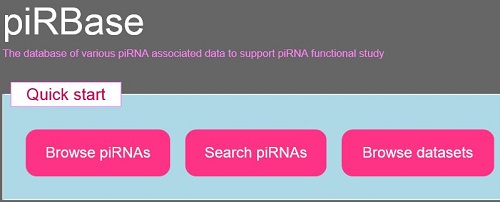piRBase-A comprehensive database of piRNA sequences
On October 29, 2018, a database developed by the Center for Health Big Data Research (Institute of Biophysics, Chinese Academy of Sciences), entitled piRBase: a comprehensive database of piRNA sequences was published in `Nucleic Acids Research`. PIWI-interacting RNAs (piRNAs) are a class of small RNAs that is most abundantly expressed in animal germline, and are generally 24–31 nucleotides in length with 2`-O-methylation at their 3` ends in most animals. piRNAs play various functions in germline and somatic tissues. PIWI/piRNA complex can repress the activity of transposon, which has a high risk of damaging the genome, through post-transcriptional silencing or heterochromatin formation. Recent studies have found that piRNAs can target mRNAs by base pairing, and can be involved in sex determination through down-regulation of target genes. Besides transposon and mRNA, a large number of lncRNAs are revealed to be mediated by retrotransposon derived piRNAs in mouse late spermatocytes. As piRNAs are implicated in transposon and gene regulation, there has been a budding interest in defining the role of piRNAs in human disease. piRNAs are garnering more and more attention in a variety of cancers.
piRBase is a manually curated resource of piRNAs, which focused on piRNA function analyses as well as piRNA annotation. The database collects, annotates, and visualizes relevant data and will be a valuable contribution to the field of piRNA.
Dr. HE Shunmin and his collaborators released the first version of the piRBase in 2014 (Database (Oxford), 2014). piRBase is the expert database about piRNA included by RNAcentral and is the first database that systematically integrates various piRNA associated data to support piRNA functional analysis. Thereafter, they systematically discovered piRNA-mediated cleavage of mRNA in mouse testes (Cell Research, 2015) and trained a support vector machine classifier based on a combination of Miwi CLIP-Seq derived features and position-derived features to predict the potential targets of piRNAs on mRNAs (Bioinformatics, 2016). Based on these results and the rapidly increasing studies on piRNA, they update piRBase to release v2.0.
In the latest piRBase release, the number of unique piRNA sequences increased to 173 million, including 21 species. piRNAs in piRBase are marked as repeat- and gene-related according to their loci in genome. In addition, the piRNA target mRNA records were expanded and potential piRNA target lncRNAs were added in piRBase release v2.0. The information about eight types of cancers (breast, bladder, pancreas, gastric, liver, kidney, myeloma and colorectal cancer) related piRNAs was also added to the new version. Furthermore, they also provided new web tools and improved user interface in piRBase release v2.0. About 400 tracks of all related data from current version of piRBase were added in UCSC genome browser and users can choose to display content they are interested in.
This update was mainly completed by the Center for Health Big Data Research, Institute of Biophysics, Chinese Academy of Sciences (http://bigdata.ibp.ac.cn). The research center was established in May 2015. CHEN Runsheng is the director of the center, and HE Shunmin is the deputy director of the center. The center is mainly to carry out integrated mining analysis and research on bio-birth big data, supplemented by new technologies for development and research, and strive to build public technical support for the storage, application and sharing of omniscience data around national precision medicine and important strategic biological resources. After nearly three years of operation, the center has developed rapidly, and has completed the construction of sequencing platforms, computing clusters and data storage platforms, multi-group life data analysis platforms and data sharing platforms.
CHEN Runsheng (Institute of Biophysics) and Dr. HE Shunmin (Institute of Biophysics) are the corresponding authors. WANG Jiajia, ZHANG Peng and LU Yiping from Center for Big Data Research in Health (Institute of Biophysics) are the co-first authors of this paper. This work was supported by National Key R&D Program of China [2016YFC0901702]; National Natural Science Foundation of China [31871294].
Article link: https://doi.org/10.1093/nar/gky1043

piRBase website :http://regulatoryrna.org/database/piRNA/
Reference:
Yuan, J., Zhang, P., Cui, Y., Wang, J., Skogerbo, G., Huang, D.W., Chen, R., and He, S. (2016). Computational identification of piRNA targets on mouse mRNAs. Bioinformatics 32, 1170-1177.
Zhang, P., Kang, J.Y., Gou, L.T., Wang, J., Xue, Y., Skogerboe, G., Dai, P., Huang, D.W., Chen, R., Fu, X.D., et al. (2015). MIWI and piRNA-mediated cleavage of messenger RNAs in mouse testes. Cell research 25, 193-207.
Zhang, P., Si, X., Skogerbo, G., Wang, J., Cui, D., Li, Y., Sun, X., Liu, L., Sun, B., Chen, R., et al. (2014). piRBase: a web resource assisting piRNA functional study. Database (Oxford) 2014, bau110.
Contact: Shunmin He
Institute of Biophysics, Chinese Academy of Sciences
Beijing 100101, China
Phone: 86-10-64887032
Email: heshunmin@ibp.ac.cn

